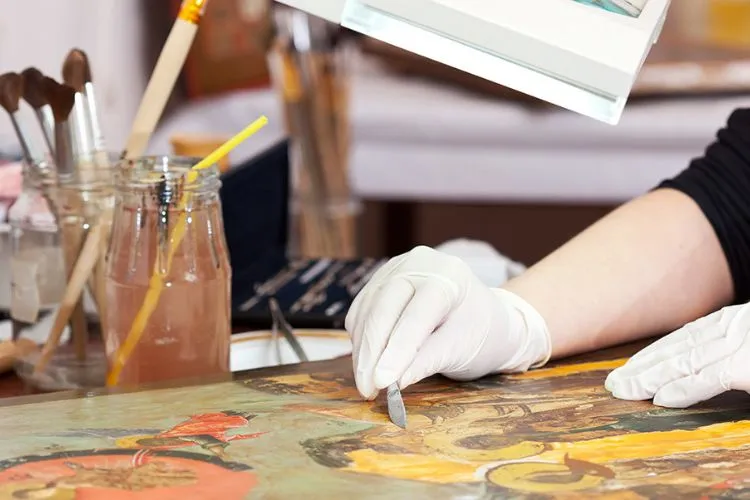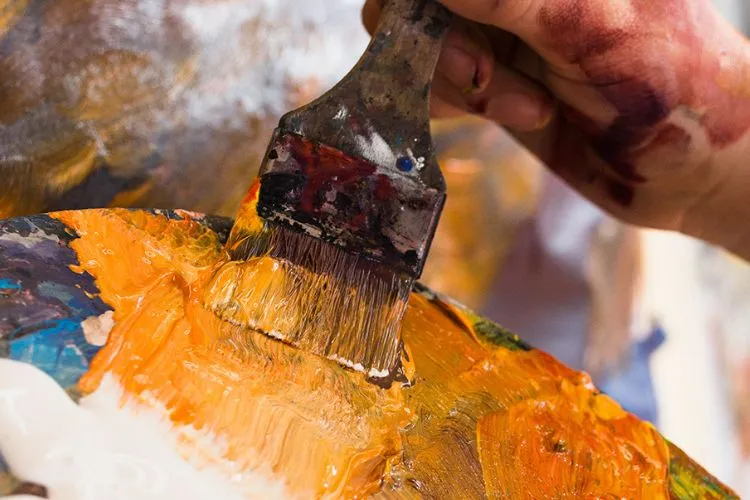With its vibrant colors and quick drying time, acrylic paint holds a special place in the hearts of artists and DIY enthusiasts.
However, when we think about painting on metal, questions arise regarding the compatibility of acrylic paint with metallic surfaces. So, does acrylic paint work on metal?
In this article, we will delve deep into whether acrylic paint works on metal, and if so, how to ensure long-lasting and vivid results.

Understanding Acrylic Paint
Acrylic paint is a water-based, fast-drying paint known for its versatility and durable finish. Consisting of pigment suspended in an acrylic polymer emulsion, it’s water-soluble but becomes water-resistant when dry.
Its fast-drying property, coupled with its ability to adhere to a wide variety of surfaces, makes it a favored choice among painters.
Metal as a Canvas
Metals like aluminum, steel, and copper offer interesting canvases for painting projects. However, metal surfaces pose unique challenges.
They are smooth and non-absorbent, which can make paint adhesion difficult. These challenges can be overcome with proper surface preparation.
Does Acrylic Paint Work on Metal?
Cleaning the Metal
The first step in preparing metal for painting is cleaning. Removing any grease, dirt, and rust is crucial for ensuring the paint adheres properly.
Grease and dirt can be wiped away with a cloth soaked in isopropyl alcohol or soapy water. If there’s rust, a wire brush or sandpaper can be used to remove it.
Sanding the Surface
Once clean, lightly sanding the metal helps by creating a slightly rough texture for the paint to grip onto.
A medium-grit sandpaper, such as 220, is ideal for this purpose. Sanding should be done evenly across the surface to ensure uniform adhesion of the paint.
Applying a Primer
Priming the metal is vital for durable and vibrant paint results. A primer acts as a base layer that enhances paint adhesion and provides an extra layer of protection against elements.
For metal surfaces, self-etching and rust-inhibiting primers are most effective. They not only prevent rust but also ensure the paint sticks well to the surface.
Applying Acrylic Paint to Metal
When it comes to applying acrylic paint on metal, there are several techniques. Brush painting is the most common, but spraying or sponging can also achieve unique effects.
It is important to apply paint evenly and allow each layer to dry completely before adding another. The drying time depends on temperature and humidity, with warmer, drier conditions being ideal.

Sealing and Protecting the Paint Job
To protect the acrylic paint and ensure its longevity on metal, sealing is essential. Sealants, such as varnish or lacquer, protect the paint from scratching, fading, and exposure to elements.
Apply the sealant in thin, even coats, allowing proper drying time between each layer. This will enhance durability and maintain the paint’s vibrancy.
Maintenance and Care
Caring for painted metal surfaces is straightforward. Cleaning should be gentle to avoid damaging the paint.
A soft cloth and mild detergent are sufficient for removing dust and dirt. In case of scratches or wear, touch-ups can be done using the same paint and sealing process.
Pros and Cons of Using Acrylic Paint on Metal
Acrylic paint offers numerous advantages, including easy cleanup, quick drying time, and versatility. However, there are some drawbacks.
Acrylic paint may chip over time and requires extra preparation and protection steps when used on metal.
Extra Tips and Best Practices

For optimal results, always work in a well-ventilated area and test the process on a small area first. Quality matters, so invest in high-grade acrylic paints suitable for metal surfaces.
Remember to work with thin layers of paint and allow each layer to dry completely. In humid conditions, using a dehumidifier can help the paint dry faster and more evenly.
You may also find useful: Does Acrylic Paint Prevent Rust? | Does Acrylic Paint Work On Leather?
Common Mistakes and How to Avoid Them
Dealing with adhesion issues and achieving a smooth texture can be challenging when painting metal with acrylics. To avoid these common mistakes, consider the following guidelines:
Ensuring Proper Adhesion
- Surface Preparation: Clean the metal thoroughly to remove oils, dirt, and rust. Use sandpaper to slightly roughen the surface for better paint grip.
- Priming: Applying a metal-appropriate primer can significantly increase paint adhesion. Make sure the primer is fully dry before painting.
Avoiding Drips and Uneven Textures
- Paint Application: Apply paint in multiple thin layers instead of one thick layer. This approach helps prevent drips and ensures even coverage.
- Correct Tools: Use the right size brushes or rollers for your project. Small brushes for details and larger ones for broad surfaces can help maintain an even texture.
- Drying Time: Allow enough drying time between coats. Rushing this process can lead to tackiness and uneven textures.
By focusing on thorough preparation and mindful application, you can minimize the risk of these common mistakes, leading to a more pleasing and durable finish on your metal projects.
Frequently Asked Questions (FAQs)
Can acrylic paint prevent rust on metal?
While acrylic paint itself doesn’t prevent rust, applying a rust-inhibiting primer before painting can protect the metal.
How long does acrylic paint last on metal?
With proper preparation, application, and sealing, acrylic paint can last several years on metal surfaces, depending on environmental exposure.
Is it necessary to use a topcoat over acrylic paint on metal?
Yes, applying a topcoat or sealant is crucial for protecting the paint from wear and tear and ensuring its longevity.
Can you use household acrylic paint on metal outdoor furniture?
Yes, household acrylic paint can be used on metal outdoor furniture, but it should be properly prepared, primed, and sealed to withstand outdoor conditions.
How do you remove acrylic paint from metal?
Acrylic paint can be removed from metal using a paint stripper or solvent designed for acrylic paints. Apply the remover as directed, then scrape the paint off carefully.
Conclusion:
Acrylic paint can indeed be used on metal, but success largely depends on proper preparation and application techniques.
By following the steps outlined in this article, artists and DIYers can achieve beautiful, lasting results on metal surfaces. Experimentation, along with adherence to best practices, will lead to the most rewarding outcomes.

Meet Isabella Anderson, your acrylic painting mentor with over a decade of brush-wielding mastery. Dive into the colorful world of acrylics with her expert guidance, featured exclusively on ‘Acrylic Authority.’ Unleash your inner artist and explore the limitless possibilities of this versatile medium alongside a true acrylic aficionado.
